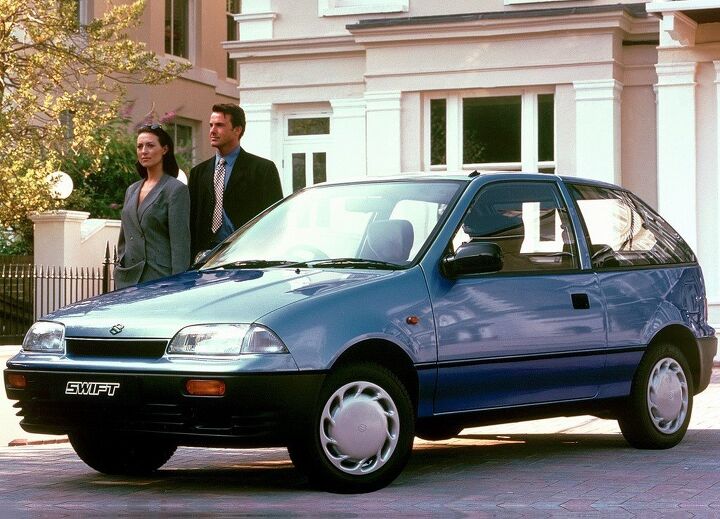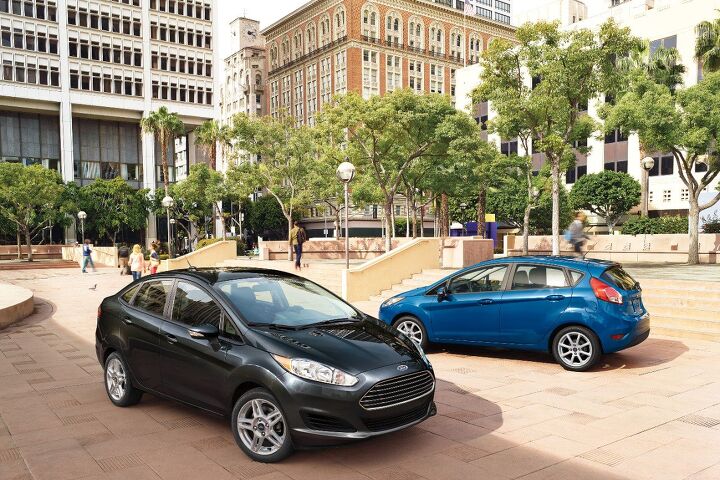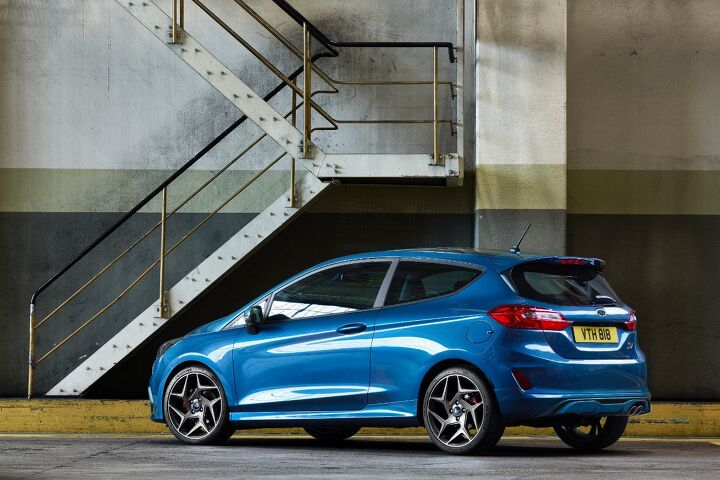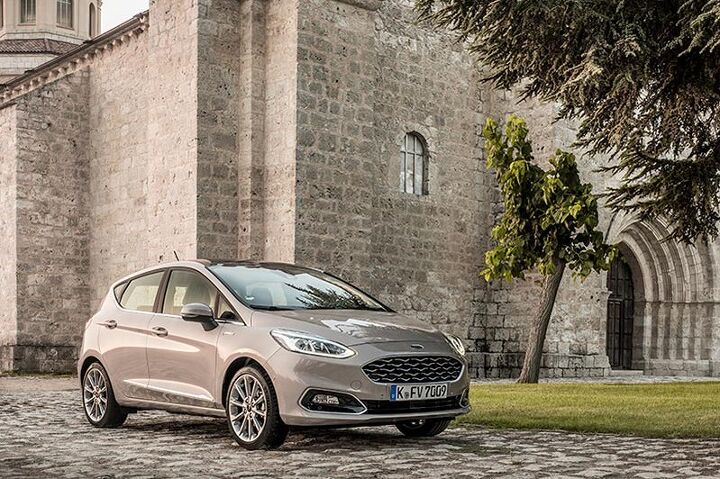#SubcompactCars
Ford's Small Car Purge Continues Apace
Two months and change after Ford Motor Company ceased production of North America’s smallest Blue Oval vehicle, Europeans are waking up to news that their tiniest offering has a date with death.
The Ka+, a name this writer can’t read without imagining a Bostonian pronouncing the word “car,” will disappear from the marketplace thanks to —what else? — fuel economy regulations that disproportionately impact small vehicles.
Hereditary: 2020 Nissan Versa Is Unmistakably Nissan, Less Entry-level Than Before
Regardless of which angle it’s viewed from, Nissan’s next-generation Versa stands atop a box and screams “Nissan!” for all to hear. From the side, you’d be forgiven for thinking someone shrunk the Maxima. Looking at the upward-sweeping character line and upstairs/downstairs door handles, its identity could be that of the new Altima. Head-on, a pedestrian might think they were being run down by a Leaf.
Yes, the 2020 Versa keeps it in the family in terms of design, donning a corporate grille and styling flourishes borrowed from its larger siblings. Perusing the car’s specs, it seems that — flat-bottomed steering wheel aside — its mission hasn’t changed one iota.
Not Every Entry-level Car Is Searching for Missing Buyers
The first quarter of 2019 reflected a long-predicted cooling off of U.S. auto sales, with volume falling 2 percent. A few automakers bucked the trend, but the news was generally unpleasant. Of course, rising average transaction prices and a bevy of high-margin trucks, SUVs, and crossovers softened the blow for those who got their lineups in order ahead of time.
One segment that gets very little attention — for many reasons — is the lowest rung of all: subcompact cars, which traditionally provide a stepping stone for buyers just entering the market. Many journos bemoan the loss of low-priced cars, claiming relatively cash-strapped Millennials stand to be priced out of the new vehicle market by rising MSRPs and interest rates. It’s true — the herd is thinning, with the last quarter bringing about the death of the Chevrolet Cruze. (This writer actually bought one; the jury’s out if anyone else out there did.)
Still, despite the industry flux, some nameplates continue to earn the love of buyers who choose to spend as little as possible on a new car.
Will the Aborted Mazda 2 Line Finally Make It Here in Full?
It’s already half here. The Toyota Yaris sedan, formerly the Scion iA, is the rebadged twin of the subcompact Mazda launched in Montreal in 2015. You’ll note that Mazda does not sell a second-generation 2 in North America, making that launch a relatively pointless endeavor for the automaker.
Now that Toyota has gone ahead and killed off the Toyota Yaris hatch (the Yaris that’s actually a Toyota), a space has opened up. Chances are good that the little hatch we didn’t get in 2015 will finally arrive in 2020, bearing another brand’s logo.
RIP: Pour One Out for the Toyota Yaris Hatch
In a less-than-shocking turn of events, Toyota has confirmed to CarsDirect that its Yaris Liftback, a slow-selling model that managed to score itself a facelift a few years back, is dead in the United States.
Official confirmation of the model’s discontinuation came from Toyota spokesperson Nancy Hubbell. Starting at $16,565 after destination, the diminutive hatch’s sales paled in comparison to that of its Mazda-based namesake, the Yaris sedan. To all observers, the Yaris hatch was a dead car … driving.
The Ford Fiesta's Not Looking Very Dead At All
Rumors of the Ford Fiesta‘s American demise have swirled ever since the 2016 launch of the seventh-generation model in Europe. On sale for the 2017 model year, the current-gen Fiesta overseas is not the current-gen Fiesta we see here. No, the older model continues on in North America, as whispers of its impending execution come and go.
Most recently, a Wall Street Journal report claimed the Fiesta would end production this year, with the Taurus sedan following it to the grave not long after.
That’s not what VIN decoder document obtained by TTAC claims.
QOTD: Thank Heaven for Little Cars?
I nearly bought a Suzuki Swift once. If memory serves me correctly, and who knows if it does, it was a 1991 model. Or a 1993. Black, with two doors and the big, honkin’, pavement-pounding 1.3-liter inline-four. A real brute!
Alas, without much money in my pocket (I was, what, 18?) and a pressing desire to not be seen as the guy in the Geo Metro, I made a fateful choice. That Swift stayed exactly as I found it, slowly decomposing in the back corner of a sketchy used car lot, and I turned my attention to another. Sadly, the affordable object of my affection turned out to be a total lemon that soured me on Chrysler Corporation for many years.
But enough about the Plymouth Sundance.
Once in a blue moon, I wonder how different my life might have turned out had I purchased that Swift and become a card-carrying member of the subcompact crowd. Maybe you don’t have to imagine the experience, though. Maybe a very small car wormed its way into your heart and never really left.
2019 Toyota Yaris Sedan: So Long, Scion, Part 2
With Monday’s announcement of a refreshed 2019 Yaris sedan comes the last shovelful of dirt heaped on Scion’s grave. Toyota has an updated version of the subcompact four-door ready for an official unveiling at this week’s New York International Auto Show, but don’t go looking for that tell-tale “iA” model nameplate. It’s gone.
The complicated history of Toyota’s smallest sedan begins with the automaker’s defunct youth brand, Scion. As the brand grew more confused (and mainstream), Toyota borrowed the recently introduced second-generation Mazda 2 sedan, slapped a Scion badge on it, and rolled out the iA. Mazda had second thoughts about offering the car in this market, making the iA and the CX-3 the only domestic adopters of the car’s platform.
For Scion, grafting a large, unusual grille onto the wee car proved sufficient in de-KODO-ifying the model. During the inaugural 2016 model year, however, Toyota grimly loaded a single round into its shotgun, took the Scion brand behind the barn, and did what it had to do. The two newest Scion models — iA and iM — kept their model names and took up residence in the Yaris and Corolla lineups for 2017, adopting their sibling’s name as a prefix (despite not sharing the same architecture).
Now, both models enter 2019 free of vestigial Scion badging.
2018 Honda Fit LX Review - What If It's the Only Subcompact for You?
Subcompacts, if they ever were in favor, have quickly fallen out of favor in the United States. In 2017, sales in the first three-quarters of the year plunged by more than a fifth, year-over-year. The Honda Fit, modestly updated for the 2018 model year, is on track in 2017 to fall to a five-year low of around 50,000 sales, a far cry from the nearly 80,000 American Honda sold a decade ago.
The Honda Fit, not now in third-gen form nor in any prior iteration, has never sold on the strength of style. There have always been less expensive subcompacts, faster subcompacts, and better-equipped subcompacts, as well.
There have not, however, at least not during the Fit’s tenure, been any subcompacts that offer the flexibility of the Honda Fit. But does the fact that the 2018 Honda Fit is likely the only current subcompact that could operate as my family’s lone vehicle make up for the fact that the Fit lags behind rivals in key areas?
2018 Kia Rio EX 5-Door Review - Can a Subcompact Car Be Good Enough in 2017 to Merit Attention?
During a year in which Kia is about to drop a BMW 3 Series-rivalling sports sedan with a price tag that rises above $50,000, it’s not hard to see why the arrival of a new Kia subcompact hatchback goes relatively unnoticed.
It’s not hard to see why the arrival of any subcompact goes unnoticed. In the United States, subcompact car sales are a pittance, forming just 2 percent of the market after losing one-fifth of their collective volume so far this year. Kia’s entry, meanwhile, fills only a narrow gap in America’s subcompact niche, suffering from a 51-percent year-over-year sales drop to only 11,952 sales in 2017’s first nine months, equal to just 4 percent of the subcompact market.
This is nothing new. U.S. interest in the Kia Rio, valued at over 50,000 annual sales way back in 2002, perked up with the dawn of the outgoing third-generation model half a decade ago but quickly diminished. Kia USA averaged fewer than 30,000 annual Rio sales over the last three years.
But you can forget the Stinger for a moment, you can set aside the K900, ignore the Cadenza, and temporarily dismiss the Sorento SX Limited. This is the 2018 Kia Rio. Kia won’t even let you spend more than $20,000 on this subcompact hatch.
Mournful Glances: Carryover 2018 Ford Fiesta Loses the $995 Three-cylinder EcoBoost Engine Option
At TTAC, we’re big fans of Ford’s 1.0-liter three-cylinder EcoBoost engine. In the right application — the sixth-generation Ford Fiesta — the EcoBoost triple is a happy revver, a fuel miser, a torque manufacturer, a smooth operator.
In fact, we’re such big fans of the EcoBoost three-cylinder that our editor-at-large bought and paid for a Fiesta 1.0 EB long-termer with his own money. That’s a strong recommendation. Recommendations don’t come any stronger than that.
With the existing, aged, increasingly antiquated Mexico-built Ford Fiesta continuing as a 2018 model year subcompact whilst much of the world benefits from the launch of a new generation of Fiestas, Ford is trimming the Fiesta lineup. The standard 1.6-liter four-cylinder persists; the Fiesta ST forges on.
But the Ford Fiesta’s 1.0-liter EcoBoost three-cylinder is signing off.
Put Those Next-Gen Ford Fiesta ST Dreams to Bed, America - It's Not Happening
Over the last seven years, America, you didn’t buy many Ford Fiestas. Fewer than 430,000, in fact. For perspective, in the much smaller United Kingdom market, Ford sold over 500,000 Fiestas in just the last four years.
But the Fiesta’s lack of popularity — and its dramatic loss of popularity in America — is not a unique-to-Ford situation. U.S. sales of subcompact cars plunged by more than a fifth, year-over-year, during the first eight months of 2017. That tumble comes after U.S. sales of subcompact cars declined in 2015 and 2016, as well.
Nevertheless, it comes as no surprise that Ford, after exploring America’s affordable avenues for one generation of Fiesta, isn’t bringing the seventh-generation version to America. And now we have confirmation that there is absolutely no hope the next-gen Ford Fiesta ST will come stateside, either.
Evidence Exhibit #127 In the Case of Market V. Small Cars: Volkswagen Considering Pulling the Up City Car From Europe
The global auto industry is not a place in which small car production is as straightforward as it was a decade or two ago.
Brought closer to home, Americans are buying roughly 30-percent fewer subcompact cars now than they were just three years ago. With next to no fuel economy advantages; limited payment upside; and less refinement, power, and space, why would a car buyer choose a subcompact over a compact sibling? Most buyers don’t. In the United States, compact car sales are five times stronger than subcompact sales. August’s top three compacts (Civic, Corolla, Cruze) outsold their subcompact brethren (Fit, Yaris, Sonic) by more than seven-to-one.
Many automakers don’t even bother selling their smallest cars in North America. Mazda’s latest 2 never saw U.S. import. FCA has left the compact market, having long since left the subcompact sector to rivals. Subaru doesn’t dive below the Impreza platform. And Volkswagen stops at the Golf, leaving the subcompact Polo for more small-car-friendly countries.
But how keen on small cars are those other countries? In some instances, not keen enough. Volkswagen boss Herbert Diess tells Autocar, “Selling small cars is not easy.” And he’s clearly not just talking about F-150-loving America. “It’s a very European problem,” says Diess. As a result, the Volkswagen Up city car, a Lupo successor, may pull out of Europe in favor of emerging markets only.
Ford Motor Company's Antonella Wants a Nicer Fiesta Now, but There's No Antonellas in America
Remember Antonella?
Antonella was a 28-year-old Italian, living in the heart of Rome in the latter part of the last decade, who needed a nimble and stylish Ford.
Antonella has changed. Antonella has more money. She no longer lives with her parents. She has, say it politely, aged, though she’s “still very expressive,” Ford of Europe’s design boss George Saridakis tells Automotive News Europe. Since Antonella changed, the Ford Fiesta for which she was created (or vice versa) has also changed. Ford of Europe now hopes 10 percent of Europe’s Antonellas will choose the upmarket Fiesta Vignale.
What about Antonella’s cousin, Amy in Cleveland? Ford probably hopes she’ll buy a 2018 EcoSport. But if we’re going to be honest about Amy (a TTAC creation), we all know Ford’s inadvertently pulling her into the leftover 2017 Escape she’s been eyeing, the one with a $2,500 discount and interest-free financing over 84 months.
Do It for the Children: Honda and Toyota Sticking With Small Cars for the Sake of Our Children, and Our Childrens' Children
The Dodge Dart is dead. The Ford Fiesta is likely on its last legs in the United States. Ford Focus production is moving to China, off the North American continent where demand for Ford small cars is rapidly declining. General Motors is scaling back production at the Chevrolet Sonic’s Orion Township, Michigan, assembly plant.
That’s the Detroit small car picture, or at least part of it. From Japan’s perspective, however, small cars are entirely worth it, not just because of the sales success enjoyed by the Honda Civic (currently America’s best-selling car through 2017’s first seven months) and Toyota Corolla, but because of the demographic small cars target.






























Recent Comments